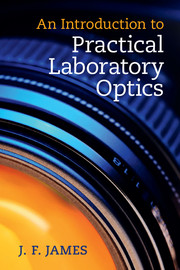Book contents
- Frontmatter
- Contents
- Preface
- 1 Introduction: centred optical systems
- 2 Telescopes and binoculars
- 3 Eyepieces, eyes and colour
- 4 Cameras and camera lenses
- 5 The scientific CCD camera
- 6 Spectrometry
- 7 Interferometers and their uses
- 8 Electro-optical effects and their practical uses
- 9 Microscopes and projectors
- 10 Siderostats and coelostats
- 11 The detection and measurement of radiation
- 12 Practicalities
- Appendix A Gaussian optics
- Appendix B Optical aberrations
- Appendix C A brief introduction to Fourier optics
- Further reading
- Index
2 - Telescopes and binoculars
Published online by Cambridge University Press: 05 October 2014
- Frontmatter
- Contents
- Preface
- 1 Introduction: centred optical systems
- 2 Telescopes and binoculars
- 3 Eyepieces, eyes and colour
- 4 Cameras and camera lenses
- 5 The scientific CCD camera
- 6 Spectrometry
- 7 Interferometers and their uses
- 8 Electro-optical effects and their practical uses
- 9 Microscopes and projectors
- 10 Siderostats and coelostats
- 11 The detection and measurement of radiation
- 12 Practicalities
- Appendix A Gaussian optics
- Appendix B Optical aberrations
- Appendix C A brief introduction to Fourier optics
- Further reading
- Index
Summary
The visual telescope
This is an elementary type of optical instrument.
The historically acknowledged function of a telescope is to produce an enlarged virtual image of a distant object for inspection by the observer's eye. Both object and image are at −∞ in normal focusing mode, but by shortening the tube a little the image can be brought nearer to the observer's eye to allow for myopia. In effect the objective forms a real image of a distant object and the eyepiece re-collimates the light so that the final image, like the object, is at −∞. The lens of the observer's eye then focuses this virtual image on to the retina.
An unusual but equally valid alternative is to regard a telescope as a device which puts an enlarged, real image of the observer's eye-pupil at the telescope's objective. If the telescope is properly designed, the image of the eye-pupil will exactly correspond in position and diameter to the clear aperture of the objective. The enlarged, virtual eye would then see the distant object exactly as the actual observer sees it, but in appropriately greater detail.
What all this implies is that the observer's eye-pupil and the telescope objective are conjugate points in the complete optical system of telescope and eye.
- Type
- Chapter
- Information
- An Introduction to Practical Laboratory Optics , pp. 15 - 29Publisher: Cambridge University PressPrint publication year: 2014



